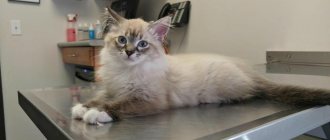What will you learn from the article?
- When to castrate a cat?
- Is it worth doing?
- How to prepare a cat for surgery?
- How does the operation take place?
- How to care for a cat after castration After local anesthesia
- After general anesthesia
- When to contact a veterinarian immediately
- Prices
By 6-8 months, cats reach sexual maturity, and the owners need to make an important decision - to castrate the cat or start looking for a bride for him. From the article you will learn what castration is, when it is performed, how to prepare a cat for it, what you need to know about this operation and the features of caring for pets after.
Castration of a cat is a surgical operation to remove the gonads from an animal.
After removing hair from the scrotum area, the doctor makes incisions, cuts off the spermatic cords, and removes the testes. The operation takes place under general anesthesia or local anesthesia.
When to castrate a cat?
At 6-12 months
According to veterinarians, the optimal age when cats can be castrated is from 6 to 12 months. At this age, the condition of the genital organs is ideal for surgery, and the influence of sex hormones on the animal is minimal. It is best to carry out the operation before the cat has time to “walk”.
What happens if you choose a different age?
If you castrate a cat too early, the animal's development may slow down. The level of sex hormones affects the rate of muscle growth. Early castrates can be smaller than their relatives and look like 10-month-old kittens until old age.
Castration too late (after 2-3 years) leads to the fact that the animal has already been formed under the influence of sex hormones and has certain habits. Therefore, after the operation the cat can continue to behave the same as before. The second disadvantage is that cats that were operated on late have a higher risk of developing obesity. Third, adult cats have a lower pain threshold, so the operation must be performed under anesthesia.
Optimal age
Of course, a lot depends on the breed and individual characteristics of the animal. There are no specific deadlines for neutered cats. The average period of puberty in cats is 7-11 months. In any case, it will not be a mistake if the operation occurs a year later. This time is enough to avoid health problems in the future.
Castration, like any intervention in the body, brings certain hormonal and behavioral changes.
In any case, the sex life of your beloved pet will be a surprise for the owner. Even if the cat lives in an apartment and leads a passive lifestyle. An animal cannot resist its instincts and get carried away by a cat during a walk or run away on the street when arriving in a village or dacha.
Timely castration will avoid unnecessary frustration and loud cat concerts. Calls to search for a cat may be accompanied by aggressive behavior, uncontrolled marking of territory and loud meowing.
For clarity, we note obvious signs when a cat should be castrated and the maximum age for surgical or other intervention in natural processes:
- The cat has noticeably lost weight . It is worth keeping in mind adjustments for the time of year and breed. Cats, as a rule, lose weight closer to spring and summer because... There is no urgent need to maintain fat reserves. The animal refuses its favorite treats.
- Changes in behavior, mood. The cat snaps, behaves aggressively even with children, can “swear” at his favorite toys and damage furniture.
- The cat sleeps less and becomes restless. Night activity increases significantly, which causes problems for the owners.
- The cat watches the owners at the front door, meows loudly, and tries to sneak out into the street.
- The pet may rub its body parts against various objects . The emphasis will be heavily on the genitals and the fifth hairy point.
- Active marking of territory begins in the most unexpected and inappropriate places.
In general, a cat can be castrated up to the age of 3 years. But you shouldn’t delay or postpone the operation. Each time the pet’s mood and behavior will worsen. Even special tablets and drops will not help.
ATTENTION! There is an opinion among owners that a cat should be castrated only after the first mating. This is true for cats, but with males the situation is somewhat different. A cat that has satisfied its physical needs and then is deprived of this opportunity may experience enormous stress in the future.
Is it worth doing?
Pros:
- Change in behavior, lack of aggression;
- The cat stops marking his territory. Even if the instinct persists for some time after the operation (this is possible with late castration), the smell of urine becomes less pungent;
- The animal will not strive to leave its home - the risk that the cat will run away for a walk is reduced;
- The risk of developing malignant genital diseases is reduced several times.
Consequences (cons):
- The risk of the operation itself, performed under general anesthesia. To reduce it, do not neglect preparatory measures, carefully choose a clinic and veterinarian. Do not forget about a preliminary consultation with a veterinarian, choose modern anesthesia and procedure techniques.
- Risk of postoperative wound infection. Follow all doctor's recommendations, treat the wound, and prevent scratching and licking. If infected, contact your doctor immediately for treatment.
- Risk of pet obesity. After surgery, provide your cat with more active physical activity. Pay enough attention to your diet - reduce the serving size. After consulting with a veterinarian, switch the cat to specialized food for castrates.
Pros and cons of castration
The pros and cons of castrating a cat is a list that differs from the point of view of scientists and ordinary people. Veterinarians see only positive things in the operation. Neutered cats live 1.5-2 years longer than usual, do not mark their territory and do not show aggression.
Animals stop meowing at night and become as obedient as possible. You can forget about prostate adenoma and sexually transmitted infections. They do not threaten a castrated cat. Tumor processes after surgery are also unlikely, especially if the intervention was performed on a young pet.
Cat owners also find downsides to castration, noting that many animals become obese. This is due to the laziness of those who underwent surgery. Leading a sedentary lifestyle and not being interested in the opposite sex, people with mustaches find solace in food.
However, obesity is the result of an incorrectly selected diet and diet, veterinarians note.
Doctors admit only one objective disadvantage of castration - an increased risk of developing urolithiasis. Systematic surveys are required in this regard.
How to prepare a cat for surgery?
The operation is dangerous for an animal with a weakened immune system, in the presence of diseases and during the recovery period. Therefore, the decision about castration surgery should be made after examination and consultation with a veterinarian. And the animal must be properly prepared for it.
Preparation for castration surgery:
- Preliminary inspection. It is carried out by a veterinarian to assess the general state of health and identify possible contraindications to the operation. As part of the examination, urine and stool samples are taken. In some cases: late castration, breed characteristics (British and Scottish cats), examination by a cardiologist, ultrasound of the heart and cardiogram will be required.
- Vaccination. The cat must have all necessary vaccinations and undergo a quarantine period (3-4 weeks).
- Anti-flea and anthelmintic treatment. 3 weeks before the proposed operation, the cat must be removed from fleas and worms.
- Anti-stress measures. In case of increased nervousness and excitability of the animal, the veterinarian prescribes sedatives 2-3 days before surgery.
- Laxatives. As prescribed by the doctor, a laxative is given 12-24 hours before surgery. So that immediately after the operation the animal does not have the urge to go to the toilet. This can negatively affect the healing of the wound and cause pain in your pet.
- Fasting and drinking regime. The animal is stopped feeding 12-16 hours before surgery. Access to water is stopped 3-4 hours before the procedure. If the cat's stomach is full, the anesthesia can cause a gag reflex - this is dangerous.
Video about preparing for surgery:
https://www.youtube.com/watch?v=88l0Q9o3nfg
Description of the procedure and indications for it
Castration is carried out for cats of any breed.
Castration of cats is carried out to eliminate periods of sexual heat in animals that do not have the opportunity to mate. The procedure simplifies the life of the owners and is required for the cats themselves, since if they cannot satisfy their mating needs, they begin to suffer from mental disorders and inflammatory diseases of the genitourinary system.
Free-roaming cats during the “wedding” period, when natural instinct pushes them to search for a cat, often die because they temporarily lose their sense of danger and lose vigilance.
Veterinarians also identify mandatory indications for castration, the main of which are:
- traumatic injury to the scrotum, spermatic canal or testis itself;
- pathologies in the development of the reproductive system;
- orchitis;
- special aggressiveness of the cat during the hunting period.
Castration of cats takes place under anesthesia, which is administered intravenously. Thanks to this, the animal does not experience pain during the operation. Anesthesia is maintained for 2-3 hours after surgery.
The hair from the scrotum is removed and incisions are made in the skin and lining of the testicles. The spermatic cords are then ligated and the testicles (testes) are cut off. A suture is not applied after the procedure, as it is not necessary.
Then the cat comes out of anesthesia on its own or is removed by a veterinarian using medications. The duration of the operation itself is 10 minutes.
Important! Despite the simplicity of the operation, it must be performed by a veterinarian with experience in operating cats.
How does the operation take place?
The first thing a doctor does in a clinic or at home is administer anesthesia. The veterinarian selects the type of anesthesia depending on the pet’s condition after examination and its age.
- Intravenous anesthesia. The most effective and safe anesthesia. It goes away quickly and is easily tolerated.
- Intramuscular. The classic method is affordable.
- Inhalation. Expensive and complex, practically never used.
After the animal is put under anesthesia, the veterinarian removes the hair and disinfects the surgical area. A longitudinal incision is made in the scrotum area with a sterile scalpel.
The doctor removes the testis from the scrotum and ties the spermatic cord with a self-absorbing thread to prevent bleeding. After this, the testis (testicle) is excised. In a similar way, the doctor repeats the procedure for the second testis (testicle).
The wound is dried with a sterile cloth and treated with an antibiotic-based spray. In veterinary medicine, two surgical technologies are used: with self-absorbing sutures and sutureless. After the wound heals, a small scar of 1.5-2 cm remains.
Video:
Types of anesthesia
For castration, local or general anesthesia is used. Local anesthesia is used locally, on a specific area of the body, or the anesthetic is injected into several points on the body. After local anesthesia, the pet’s body recovers faster. Anesthesia is administered using a syringe.
General anesthesia involves certain risks to your pet's health. Before applying general anesthesia, the animal must be examined and checked for failures and disturbances in the functioning of the cardiovascular system.
During general anesthesia, anesthesia is administered in two ways:
- Injection method - the medication is administered intramuscularly or intravenously. Intravenous administration provides a quick effect and you can begin to act in 1 – 2 minutes. When administered intramuscularly, the anesthesia begins to act only after 20 minutes. This method can cause complications on the body. As a rule, it is used in relation to aggressive animals.
- The inhalation method involves administering anesthesia through the lungs. This type of anesthesia causes virtually no harm to the body. The risks are minimal. Recovery from anesthesia occurs in 3–4 minutes.
A combined method of anesthesia can also be used for castration. When it is necessary to immobilize a pet, they first use a sedative and then insert a tube into the mouth (in the case of the inhalation method).
How to care for a cat after castration
The nature of postoperative care depends on what kind of anesthesia was used: local anesthesia or general anesthesia.
General requirements:
- After surgery, your cat will have chills. Prepare in advance a secluded, warm place to rest. Change the bedding to clean and ironed cotton fabric;
- Do not place the cat in a high place. It should be located on the floor. After surgery and anesthesia, the animal will have poor coordination of movements and may fall;
- Move the tray closer to the resting place to make it easier for the cat to get to it;
- Remove litter from the tray. The granules can injure or clog the wound. Instead of filler, you can use disposable pet diapers;
- If the cat does not go to the toilet in the litter tray, and this can happen, do not scold the animal;
- If the cat tries to lick a wound, use an Elizabethan collar.
After local anesthesia
After local anesthesia, the cat is conscious and all that is required from its owner is to treat the postoperative suture (if necessary) with special antiseptic agents, as well as thoroughly clean the litter box after each trip to the toilet. The animal may be inactive and look for a secluded place - if this lasts a short period of time after the operation, then there is no need to worry.
After general anesthesia
After general anesthesia, the cat will sleep for some time, and when it wakes up it will be weakened and disoriented. While the animal is recovering from anesthesia, it walks poorly, staggers and can easily injure itself - do not leave it unattended!
Do not force your cat to drink or forcefully offer food. The first meal can be 8-12 hours after surgery - the food should be light and in small quantities.
If your pet has a dry mouth, you can drop a couple of drops of water into the mouth to moisten the tongue. Do not force-feed copious amounts of water. The animal will drink on its own when it fully recovers from anesthesia.
When to contact a veterinarian immediately
- After castration, the pet does not eat for more than 2-3 days;
- On the first day after surgery, an increase in body temperature is observed;
- The cat has difficulty breathing, paleness or severe redness of the oral mucosa;
- Swelling has appeared.
A cat's recovery after surgery is much faster than that of a cat after sterilization. This is due to the fact that cats have a less invasive operation, i.e. requires a minimal area of intervention with a low degree of tissue trauma.
Video - care after surgery
Should you believe castration myths?
Perhaps the most common and strangest misconception is to think that a cat’s behavior is completely similar to a person’s. The owners believe that they will deprive their pet of the “joy of love” or “manhood,” but this is a huge misconception. Mammals (with the exception of humans and dolphins) do not experience pleasure from intercourse; sex hormones dictate certain actions to them.
Perhaps, only if the cat protects the territory of a private house from other cats, raccoons, hedgehogs and others, does he need to stay with the testes. But then be prepared for his constant fights, injuries and absences for adventures. Unneutered village cats live significantly less than their domestic counterparts, and their lives are far from easy.
Therefore, if you have an exclusively pet kitten, you need to take it for a minor operation. And in order not to worry, get acquainted with common myths that are not justified in any way:
- Cats become lazy and get fat
. A cat that has been castrated at a fairly mature age (after about 7-8 years) can become lazy. In all other cases, the animal remains active and cheerful. As for obesity, any four-legged animal with improper nutrition will gain excess weight, so the question is not the operation, but what you feed your cat. Choose good food or create a natural menu under the guidance of a veterinarian - and everything will be fine.
- The animal will become aggressive
. This myth has been debunked by many counterexamples. It is uncastrated males, unsatisfied in their desire, who become very angry (not all, but many, especially by the age of 5-8). Their nature is to fight for females, and if they do not fight with their relatives, they will get it from their owners. There are more than one or even a thousand stories about how cats seriously injured their owners, and it was all due to raging instinct. Unfortunately, late castration will not save such individuals - we can only talk about euthanasia, since the animal becomes dangerous to others.
- The cat will have problems with the genitourinary system
. Again, it all depends on feeding and not on minor surgery. If you choose the right diet and give your animal only clean bottled water, urolithiasis will bypass it.
- Surgery is a big burden on the body
. With a small error we can agree with this statement, but! Nowadays, most veterinarians use light anesthesia, from which the cat recovers very quickly. The operation itself is not abdominal, so the risks of complications are minimal. The very next day the pet returns to its normal life and does not experience any discomfort.
In conclusion, we can say that some cats, even after castration, continue to perform “acts” with a cat, a chair leg, a blanket, a soft toy, etc. This means that the cat remains a “man,” which is important for many owners.
Complications after surgery
The reaction to surgery is individual for each animal. After castration surgery for a kitten, the following complications are possible:
- Vomit. Typical reaction to anesthesia. If the cat vomits once and not profusely, make sure that the animal does not choke in the vomit. Turn the cat's head to the side. If vomiting is severe and uncontrollable, immediately inform the doctor who performed the operation.
- Hyperthermia. Fever, drowsiness and weakness are a normal reaction of the animal to surgery and anesthesia. This condition occurs in all cats in the first postoperative hours and can last up to 2 days. If the animal's body temperature is above 39°C and lasts more than 1-2 days after surgery, contact your veterinarian.
- Refusal to eat, lack of appetite. Fasting on the first day after surgery is normal.
- Reduced temperature. If the animal's body temperature drops below 37°C, cover it with warm heating pads. If this does not help, urgent medical attention is needed.
- Infection of a postoperative wound. Slight redness or swelling is allowed in the first 3-4 days after castration. If redness or discharge from the wound increases, you should seek help from a veterinarian.
- Inflammation of the stump of the spermatic cord. It can develop in cats in the first week after surgery. This is indicated by: lethargy, painful swelling at the operation site and an increase in the cat’s body temperature.
- Internal hemorrhage. You should be alert to: weakness and lethargy of the cat, drowsiness, pale oral mucosa (white). Each touch to the animal will cause a painful reaction in it. You cannot do without the help of a veterinarian.
- Obesity. Changes in the animal's hormonal levels after surgery cause metabolic disorders. He slows down. Possible weight gain. Do not overfeed your cat and create a balanced diet.
Important!
Stay close to your cat after surgery and contact your veterinarian if any suspicious symptoms occur.
What is the price
Russia
- Moscow and St. Petersburg – 1000 – 3000 rubles;
- Regions of Russia – 850 – 2500 rub.
Ukraine
- Kyiv – 350 – 900 hryvnia;
- Regions of Ukraine – 250 – 500 UAH;
Be careful when choosing a clinic. If a small and attractive price is indicated, it is quite possible that this is a marketing ploy with which they are trying to lure you.
A suspiciously low price for castration indicates that you may be additionally billed for anesthesia, medications and consumables. Take the time to find out everything in detail before you sign up for the operation.
Is it worth castrating a cat at home?
If you do not want to take your pet to the clinic or are unable to do so, consider having neutering surgery at home.
Features of preparing and performing surgery at home
- The animal is prepared in the same way as for an operation that is performed in a hospital setting;
- You need to prepare a clean room. A bathroom that is washed using household disinfectants, dried and ventilated is best suited. It is impossible to achieve sterility at home, but it is not necessary. Castration is not an abdominal operation;
- A table for surgical procedures is installed in the prepared room. It is also disinfected.
Pros:
- Saving time on transporting the animal to the clinic;
- The animal does not experience stress from transportation;
- After the operation, the cat is in a familiar environment, he recovers faster;
- There is no risk of infection from other animals.
Minuses:
- Inability to achieve sterility;
- There is no equipment for resuscitation measures. It may be needed if the animal has an individual negative reaction to anesthesia or medications;
- Calling a specialist to your home is more expensive and may depend on the distance of the house from the clinic.
Prices
Russia
- Moscow and St. Petersburg – 2200 – 3000 rubles;
- Regions of Russia – 1500 – 2500 rubles.
Ukraine
- Kyiv – 500 – 900 hryvnia;
- Regions of Ukraine – 400 – 500 UAH;
Price of the procedure
The price of castration of a cat ranges from 1-7 thousand rubles. The minimum is requested by standard budget clinics, and the maximum by private clinics.
A visit from a surgeon to your home is approximately 30% more expensive than an operation in a medical institution. The price partly depends on the region and the condition of the cat. Operating on cryptorchid, for example, is more difficult.
Castration is a simple operation. For comparison, the minimum price tag for sterilization is 3 thousand rubles. The request is due to the duration of the intervention, its complexity, and the cost of medications
Alternative methods of castration
Modern veterinary medicine also knows other methods of castration (sterilization) of cats. They are used as an alternative to surgery, but not as often as the classic method.
- Vasectomy (sterilization). It involves ligating the vas deferens. The cat loses the ability to have offspring, but does not lose the ability to mate. The operation is complex and expensive.
- Radiation sterilization. Targeted irradiation of the cat's reproductive organs (testicles). The method is rare, expensive, and requires special high-tech equipment.
- Temporary chemical castration. An implant containing a substance that suppresses the animal’s sexual desire is inserted under the animal’s skin. Expensive way.
- Hormonal temporary sterilization. Once every six months, the animal is given a hormonal injection that suppresses sexual desire. This manipulation is carried out for life.
Important!
All methods can be used to castrate a kitten, but surgery is considered the most effective and safest today.
Whether or not to castrate your cat is up to you to decide. But remember that not only we humans should live comfortably, but also our pets for whom we are responsible.











